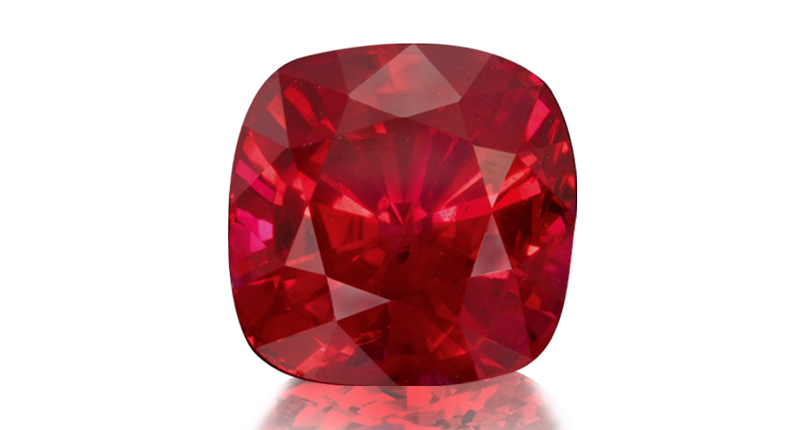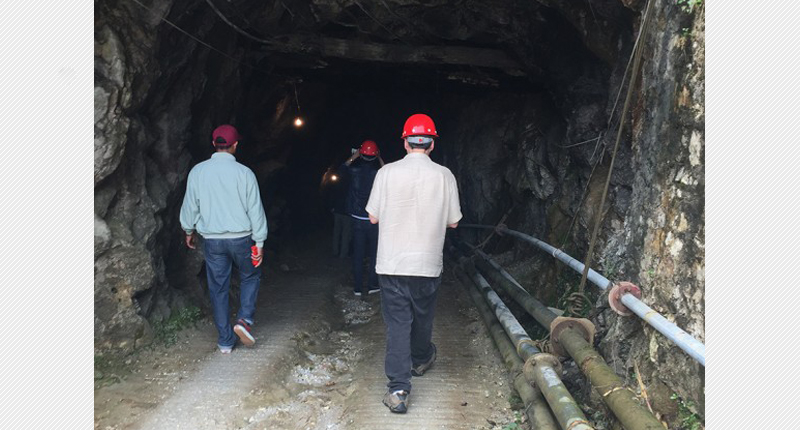Gemfields said the Zambian government revoked the 2019 suspension of the tax with no warning.
5 Things to Know About … Burmese Rubies
Senior Editor Brecken Branstrator details a few interesting facts about the stones, which have been allowed back into the U.S. for the first time in nearly a decade.

For my first “5 Things to Know About…” blog post, I chose these stones because they are topical, with the lift of the remaining sanctions and the likelihood that they will be at the upcoming gems shows in Tucson for the first time in a while.
I, for one, hope I can get my hands on at least a few while I’m out in the desert.
In the meantime, here’s are five facts about the gemstones pulled together with the help of a number of experts.
1. The color of fine Burmese rubies comes a result of two factors. According to “Ruby & Sapphire: A Gemologist’s Guide” by Richard Hughes, the first factor is a combination of the slightly bluish-red body color of the gemstone and the “purer” red fluorescent emission, which work together to give the gemstone its high-intensity color.
The second is the presence of “silk”--tiny inclusions scatter light onto “facets that would otherwise be extinct,” giving the color a softness and greater dispersion across the gem’s face.
And while rubies from other sources also can possess the strong red fluorescence and “silk” comparable to those sourced in Myanmar (formerly known as Burma), it’s the particular combination of “fine color … and facetable material (i.e., internally clean)” that puts Burmese rubies at the top.
2. Burmese rubies are much younger than those from East Africa. This is actually true for all rubies created by the collision of the Indian subcontinent with the Asian continent.
During certain times in history, tectonic movement has resulted in large-scale shifts in the Earth’s surface, resulting in mineral formation and creating regions called orogenic belts. A lot of the finest ruby and sapphire mines fall into such zones, according to Hughes’ book.
The Pan-African orogeny happened about 750 to 450 million years ago, the result of which created gem deposits in Kenya, Tanzania, Mozambique, Madagascar, Sri Lanka and southern India.

Meanwhile, the activity that resulted in the Himalayan region--the Indian subcontinent colliding with the Asian continent--occurred “just” 45 to 5 million years ago. This created ruby and sapphire deposits from Afghanistan and Tajikistan through Pakistan, northern India, Nepal and Myanmar, and onward to China and Vietnam.
Though there currently is no easy way to age-date rubies, Hughes said if we could, it would provide a method for separating Himalayan rubies from those sourced in East Africa and Sri Lanka.
3. There isn’t a great deal of fine quality rubies coming out of Burma right now. Most of the alluvial deposits in the Mogok region are mined out, according to Hughes.
He said the best gemstones come from alluvial deposits because millions of years of weathering naturally removes the impure cracked portions, which leaves behind the purest part of the crystal.
But now, without the alluvial sources, mining increasingly involves hard rock, which has lower yields and keeps production low.
In a blog post published shortly after the ban was officially lifted in October, Omi Gems also noted that even while the ban was in place in the U.S., Burmese rubies still were being exported to other countries but “supply was still not meeting that (high) demand.” This means that there’s no great supply ready to be sent to the U.S., Omi added, and that prices are likely to remain high.
4. Burmese rubies can be compared to fine rubies from Mozambique. While there are a lot of great rubies coming from other sources, it was the discovery of the fine stones from Mozambique in the late 2000s that made a great splash in the gem world, especially given the ban on Burmese material.
Where a strong presence of iron gives many other sources a slightly brownish hue, the material from Mozambique varies in iron content, so its rubies can have a fluorescence and color hues in similar to the classic colors of Burmese rubies, according to gemologist Richard Wise’s “Secrets of the Gem Trade (Second Edition).”
In his book, Wise wrote that he has seen several stones from Mozambique that “rival, in hue, saturation the best Burma has to offer.”
This is good news for the industry given that there’s so little coming out of Myanmar right now, as mentioned before, and as Mozambique rubies today make up a large part of what’s on the market.
Wise, in fact, estimates that about 85 percent of the ruby market today is made up of Mozambican goods.
And as production from Myanmar continues to decrease--assuming the supply of Mozambican rubies remains strong--he price gap between Burmese and African rubies likely will continue to get smaller.

5. The conflict surrounding Burmese rubies has changed. The U.S. declared a “national emergency” with respect to the Burmese military’s rise to power in 1997 and started to impose sanctions on the country a short time later.
The U.S. government then specifically targeted the import of gemstones with the Tom Lantos Block Burmese JADE (Junta’s Anti-Democratic Efforts) Act of 2008, noting the human rights violations of the ruling regime and how it was evading sanctions by concealing gemstone origins to continue their export to the U.S.
Now, as we all know, the remainder of those sanctions have been lifted and rubies can once again be shipped into the country.
In October, leaders from the American Gem Trade Association and Jewelers of America took a trip to Myanmar to discuss trade between countries. While they were there, the group traveled to Mogok, the center of the gemstone trade in Myanmar and traditionally the source for the best rubies, to visit mines and with miners and dealers.
The AGTA has since released a report on its findings and the recommendations the delegation is making to officials of Myanmar.
The report states that “most of Myanmar’s rubies are in conflict-free zones, with the exception of small deposits in Mongshu in Shan State.”
Thus, the safety of workers, mine operators and prospectors, is greater and the “likelihood of indirectly funding armed conflict is less,” the report states.
(This is, of course, looking specifically at rubies in Myanmar. Jade and the problems surrounding it are a separate issue.)
Still, the AGTA hade made recommendations to the country’s officials on how to make their gemstone industry more transparent and develop it--including separating jade from other gemstones when it comes to licenses and regulations--and will continue to help it develop in the future.
The Latest

With versions in 18-karat gold and platinum, the wearables company is blending health technology and fine jewelry.

The executive brings more than two decades of industry experience to the role.

The new year feels like a clean slate, inspiring reflection, hope, and the motivation to become better versions of ourselves.

The New York City-based retailer is bringing its curation of jewels to a pop-up shop at Love Binetti in Palm Beach, Florida.


Created by JA and DCA, the fund is collecting money for jewelry businesses damaged by the wildfires in Los Angeles County.

Several jewelry designers are lending a helping hand to charities in Los Angeles amid the raging wildfires.

A Diamond is Forever hosted a holiday celebration in honor of their new marketing campaign, ‘Forever Present.’

Adrien Brody received his first Golden Globe while wearing the “Mozi” brooch, which depicts a spill of traditional Chinese calligraphy ink.

The pair will work together to support independent retailers in India with marketing assets, training materials, and other tools.

Officers in Champlain, New York valued the jewels, if genuine, at nearly $30,000.

The “Moonlight Rhapsody” collection is overflowing with gemstones, from raw opal to morganite and spessartite.

The seminar series covers topics from market trends and colored stone terminology to working with museums and growing an Instagram profile.

The artist collaborated with industry creatives on the project, which features five fictional stories and five corresponding paintings.

Nine jewelers donated jewels for a raffle to support the Children’s Hospital Foundation at Virginia Commonwealth University.

Miss Piggy shared her thoughts on being fabulous, the importance of accessories, and how to be your own cheerleader.

“Promise by Effy” includes fashion jewelry and engagement rings.

The Texas-based jeweler is closing all three locations.

Zendaya’s ring, featuring an east-west set elongated cushion-cut diamond, is said to be from British designer Jessica McCormack.

Micro-influencers, customer reviews, and shoppable videos are going to be key to getting customers’ attention, Emmanuel Raheb writes.

Garnet is comprised of a group of minerals, giving those with a birthday in January options when it comes to their birthstone.

The annual award, created in memory of business coach William “Wag” Wagner, went to a retailer in Fairfax, Virginia.

Retailers and vendors can ask customers to make a donation by rounding up to the next dollar at checkout.

The wholesaler is partnering with Australian brand Cheal Opal on a new offering of calibrated stones.

Described by JSA as being “habitual offenders,” Vasile Sava and Onita Rostas have federal warrants out for their arrest in Kansas.

The Barcelona-based brand’s flagship boutique is located in New York City’s West Village neighborhood.

A solar-powered loose diamond holder rotates the stones to show off how they catch the light.




























